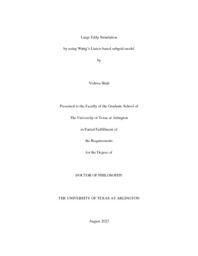| dc.description.abstract | Turbulent flows and vortex structures in fluid dynamics have been captivating researchers for decades, owing to their intrinsic complexity and significance in various industrial and natural processes. Despite their fundamental importance, the definition and identification of vortices in turbulent flows continue to pose challenges, and to date, no universally accepted approach exists. This pursuit dates to the pioneering work of Hermann von Helmholtz in the 19th century, when the concept of vortices was first introduced.
In 2019, Liu et al. introduced a novel physical quantity termed "Liutex" in scalar, vector, and tensor forms, providing a promising avenue for understanding and characterizing turbulent flows. The Liutex approach offers a comprehensive framework for vortex identification, addressing issues that plagued previous methods and paving the way for more accurate simulations and analysis of turbulent flows. Building upon this foundation, our research seeks to explore the potential of Liutex in improving Large Eddy
v
Simulation (LES) techniques.
The primary objective of this study is to investigate the effectiveness of Wang's Liutex-based subgrid model for LES in capturing the intricate dynamics and structure of turbulent flows. The research methodology involves conducting extensive numerical simulations and data analysis using high-performance computing resources. The computational results are recorded and analyzed to study the mean velocity profile and flow characteristics.
Wang's Liutex-based subgrid model is implemented within the framework of LES, allowing for the representation of small-scale fluid motions such as eddies, swirls, and vortices. These subgrid-scale features are not fully resolved in LES, and subgrid models like Liutex are essential in bridging the gap between resolved and unresolved motions, improving the accuracy and predictive capabilities of the simulations. The new model will be tested in two LES coarse grid models, a LES that is 8 times more coarse than DNS and 32 times more coarse than DNS.
The research also explores the capability of Liutex to accurately identify and characterize vortices in turbulent flows. By quantitatively assessing vortex strength, rotational axes, vortex core locations, and sizes, the Liutex-based subgrid model offers insights into the underlying mechanisms of turbulent flows that were previously difficult to ascertain.
Additionally, the application of Liutex in LES enables the study of transitional flow regimes, where the transition from laminar to turbulent flow occurs. This aspect of the
vi
research expands the understanding of flow stability and transition mechanisms, which have significant implications in engineering applications and natural phenomena.
In conclusion, this study highlights the potential of the Liutex-based subgrid model as a powerful tool for enhancing Large Eddy Simulation of turbulent flows. By leveraging Liutex, researchers and engineers can gain a deeper understanding of the complex dynamics and structures present in turbulent flows, leading to improved predictive models and design strategies in various industrial and environmental applications. The findings of this research contribute to the advancement of fluid dynamics research and pave the way for more accurate and efficient simulations of turbulent flows in the future. | |


